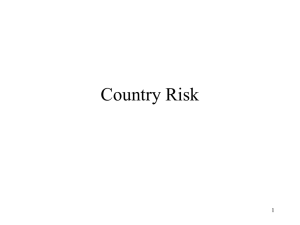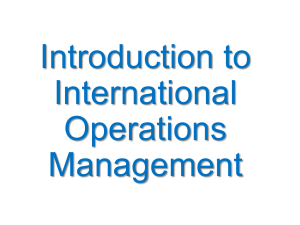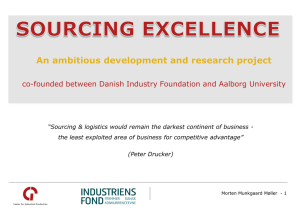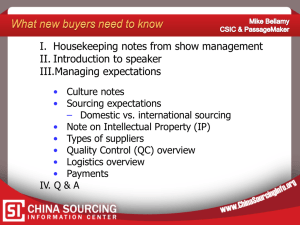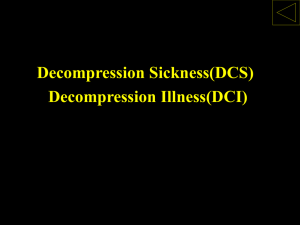Blending OR/MS, Judgment, and GIS: Restructuring P&G`s Supply
advertisement
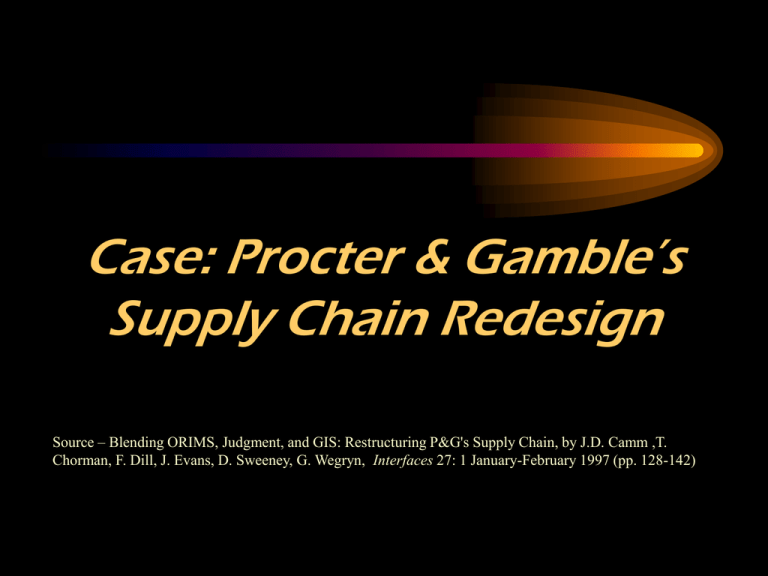
Case: Procter & Gamble’s Supply Chain Redesign Source – Blending ORIMS, Judgment, and GIS: Restructuring P&G's Supply Chain, by J.D. Camm ,T. Chorman, F. Dill, J. Evans, D. Sweeney, G. Wegryn, Interfaces 27: 1 January-February 1997 (pp. 128-142) Snapshot of P&G,1990s • Worldwide market leader in laundry detergents, diapers, feminine protection pads, shampoos, facial moisturizers, acne teen skin care products, and fabric softeners • 300 brands of consumer goods • Sales in140 countries • Operating units (plants, divisions, facilities) in 58 countries • P&G had worldwide sales of $33.5 B in fiscal 1995 and earnings of $2.64 B. Strengthening Global Effectiveness Initiative • Purposes – – – – streamline work processes drive out non-value-added costs eliminate duplication rationalize manufacturing and distribution • Scope at outset – – – – – hundreds of suppliers over 50 product lines 60 plants 15 distribution centers hundreds of customer zones representing thousands of corporate customers North American Product Supply Study • Key part of SGE Initiative • Sought reengineering of – Product sourcing – Distribution network • Principal tools – – – – Business Analytics IT network optimization models geographical information system (GIS) Five Factors Motivating Supply Chain Redesign • Deregulation of the trucking industry had lowered transportation costs • Product compaction (detergents in concentrated form, compact packaging of diapers) more product per truckload • P&G's focus on TQM improved reliability and increased throughput at every plant • decrease in product life cycles from 3-5 yr to 18-24 mo required plants to update equipment more frequently • Corporate acquisitions gave P&G excess capacity Scope of North American Product Supply Study • Five Factors motivated update of product sourcing decisions, i.e. choosing best location for production, and scale of operations for each product • Constraints and trade-offs – scope of production at any particular site is limited to products that rely on similar technologies – producing too many products at a site increases the complexity of operations – large, single-product plants exposes a firm to risk • Plant locations affect the costs of supplying raw materials and distributing finished products design of the distribution system must be considered Planning and Organization • 30 major multifunctional product-strategy teams for developing product sourcing options – aligned with P&G's major business categories: detergents, diapers, etc. – composed of individuals from various functional areas: finance, manufacturing, distribution, purchasing, R&D, plant operations – organized around product category groups that shared similar technology and could therefore be produced at the same manufacturing site • One separate distribution and customer service team charged with developing options for DC locations, assigning customers to DCs, and making transportation decisions Sourcing p1 DC1 Distribution c1 50,000 DC2 c2 p2 100,000 2 1 p3 candidate plants with fixed costs shown 3 DC3 candidate distribution centers customers with demands shown c3 50,000 3-8 Business Analytics to the Rescue • Business Analytics can identify a small set of the most promising alternative designs out of an astronomical number of possibilities – Enables product-strategy teams to collect and analyze appropriate data in order to generate detailed risk-adjusted cash flows for a reasonable number of scenarios – More important reason for sound analysis: potential impact of the project on people • P&G Analytics group partnered with University of Cincinnati's Center for Productivity Improvement Objectives of Business Analytics Team • Sourcing: to provide mathematical models and decision support for the product-strategy teams • Distribution: to provide support to a team of experts in transportation and distribution who were concentrating on warehousing, distribution, and customer allocation problems • Putting the pieces together: to ensure that the composition of a complete-supply-chain solution across product-strategy and distribution teams was the best possible Decision Support • P&G’s legacy system: mainframe-based comprehensive logistics optimization model to support sourcing decisions for multiple product categories and multiple echelons, requiring long turnaround times for each model run • New Target: simple interactive PC-based tool that would allow product-strategy teams to quickly evaluate options (choices of plant locations and capacities), make revisions, evaluate the new options, employ a GIS, and guide users to better options in an evolutionary fashion Modeling Strategy • To decompose the overall supply-chain problem into two easily solved subproblems: – a distribution-location problem – a product-sourcing problem for each product category • Reasoning – Management's organization of the strategic-planning process into a distribution team and product-category teams implied a natural decomposition across echelons of the supply chain and across product categories. – Business Analytics team determined that manufacturing and raw-material costs dominated distribution costs by a very large margin, suggesting that productsourcing decisions were not highly sensitive to the downstream distribution-system design. – Direct plant-to-customer shipments accounted for the large majority of plant shipments, suggesting that sourcing decisions were more sensitive to customer locations than to DC locations. Modeling Assumptions • For each customer zone, the proportion of demand satisfied by direct shipments as well as the proportion satisfied by shipments through DC is a constant for each product category • DC locations could be chosen independently of the plant locations, due to – relatively small volume (10 to 20 percent) shipped through DCs – small number of DCs (five to eight) needed to support that volume – fact that manufacturing costs dwarfed distribution costs DC - Customer Optimization Model • Aggregation of trade-customer demand into 150 customer zones, which provided sufficient granularity • Major considerations on the choice of DC locations – customer location – customer services – sole sourcing – proximity to customer zones to maintain current levels of customer service • Employed uncapacitated facility-location model to find optimal DC locations and to assign customers to DCs. For a fixed number of DCs, the model finds optimal locations, while ensuring that each customer zone is assigned to a single DC. The objective is to minimize the cost of all DC-customer zone assignments. DC - Customer Optimization Model Min CijXij Mixed Integer Linear Program i Xij =1, j J i Yi = k Xij Yi, i I, j J Xij = 1 if customer j assigned to DC i Yi = 1 if DC i is chosen 15 Product Sourcing Model • Transportation model for each product category: product-strategy teams specify the plant location and capacity options to be evaluated • Arc costs are the sum of manufacturing, warehousing at the plant, and transportation costs. – Manufacturing costs were the most important consideration in the product-sourcing decision, so team made careful estimates. – DC costs were composed of actual per-unit storage and handling costs at each of the company's existing DCs, and appropriate estimates at new DC locations – Transportation costs estimates were based on • negotiated rates P&G was already paying for shipments between locations, along with rate tables; or • Fixed cost per linear function of distance between 2 points Product Sourcing Model Min CijXij Linear Program j Xij = ai, i I i Xij =dj, j J Xij 0, i I, j J Xij = shipment from plant i to DC j 17 Integration with GIS • Used to display results of optimizations and manipulate data through a menu-driven system for sensitivity analysis and further model runs and evaluation • Advantages – – – – easy to understand - visualization provides insight query details by point-and-click facilitates acceptance of analytical techniques highlighted database errors 18 19 Solution Composition and Verification DC Location and Customer Assignment Distribution Team: Facility Location Model Option Generation 30 Sourcing Teams: Product Sourcing Model and Option Selection Steering Team: Logistics Modeling System @RISK NPV Model Verification 20 Project Results & Benefits • Integrated solution called for plant consolidations: by mid1996, P&G had closed 12 sites and written off over a billion dollars worth of assets and people transition costs • Over 6,000 people impacted, but treated fairly through early retirement, relocation, or retraining and placement • As of 1997, annual savings were well over $250 million (before tax) – largest portion is due to lower manufacturing expenses, operating fewer plants with less staff – some savings in packing materials and ingredients – …but with fewer DCs delivery expenses actually increased • Securities and Exchange Commission closely monitored and verified the savings

